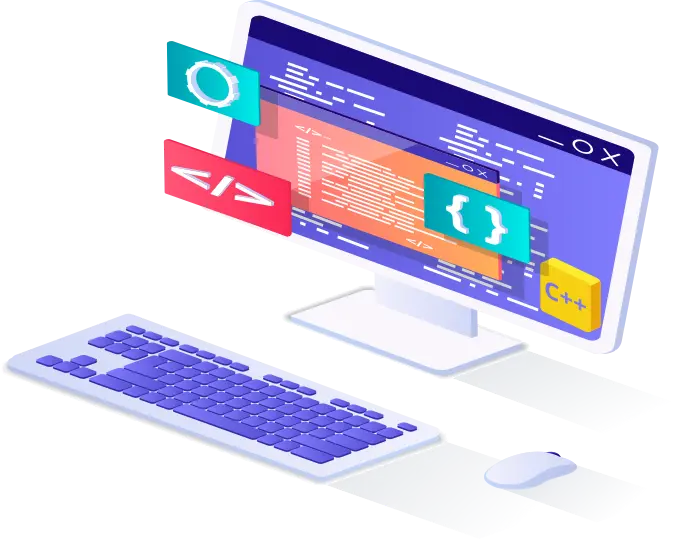In the world of web development, there are two main areas of expertise: front-end development and back-end development. While both types of developers work together to create a functional website, their areas of expertise and focus are very different. In this article, we will explore the differences between front-end and back-end development.
What’s Front-End Development?
Front-end development refers to the part of the website that the user sees and interacts with. Also known as client-side development, it involves the creation of the website’s layout, design, and user interface. It’s the part of web development that deals with the presentation layer of a website or web application. This involves designing and building the user interface (UI) and user experience (UX) that users interact with when they visit a website.
Front-end developers use a variety of tools and technologies such as HTML (Hypertext Markup Language), CSS (Cascading Style Sheets), and JavaScript to create the visual components of a website. Ideally web pages that are visually appealing, responsive, and easy to use.
HTML is the backbone of any website, providing the structure and content of a web page. CSS is used to control the style and layout of a website, including the color scheme, typography, and page layout. JavaScript is used to add interactivity to a website, allowing users to interact with the site in real-time, such as filling out forms, clicking buttons, and scrolling through pages.
The primary goal of front-end development is to create a user experience that is intuitive and engaging. Front-end developers are responsible for designing and implementing the visual elements of the website, including buttons, forms, menus, and other interactive elements. They also ensure that the website is optimized for different screen sizes and devices, ensuring that it works equally well on desktops, laptops, tablets, and smartphones.
Front-end developers need to have a solid understanding of design principles, including color theory, typography, and layout. They must also be familiar with user experience best practices, such as designing for mobile devices, accessibility, and usability.
In addition to these skills, front-end developers must be comfortable with using front-end JavaScript frameworks and libraries, such as React, Angular, and Vue. These tools help to streamline the development process and make it easier to create complex UI components and interactions.
What’s Back-End Development?
Back-end development, also known as server-side development, is the practice of creating the underlying functionality of a website. This includes everything that happens behind the scenes of a website, such as processing data, storing information, and communicating with external systems.
Back-end development involves the creation and management of the server-side of the website, which includes the web server, database, and application logic. Back-end developers use programming languages such as ASP.net, C++, PHP, Python, and Java to create the logic that powers the website’s functionality.
One of the key responsibilities of back-end developers is to create and maintain databases. Databases are used to store and organize data, such as user information, product catalogs, and transaction records.
Back-end developers must have a solid understanding of software architecture and design patterns, as well as proficiency in programming languages and frameworks. They also need a deep understanding of programming concepts such as algorithms, data structures, and databases like MySQL, PostgreSQL, and MongoDB. Back-end developers are responsible for writing the code that processes requests from the client-side and generates the appropriate responses.
Back-end developers must be able to create efficient and secure systems that can handle large amounts of data and traffic.
The primary goal of back-end development is to create a server-side application that can manage and process user requests, retrieve and store data, and perform complex operations. Back-end developers create APIs (Application Programming Interfaces) that enable different parts of the website to communicate with each other, and they ensure that the website is secure and scalable.
Differences between Front-End and Back-End Development
While both front-end and back-end developers work together to create a functional website, there are some key differences between the two roles:
Focus: Front-end developers focus on the design and user interface of the website, while back-end developers focus on the server-side of the website.
Tools and Technologies: Front-end developers use tools and technologies such as HTML, CSS, and JavaScript to create the visual elements of the website, while back-end developers use programming languages to create the logic that powers the website’s functionality.
User Interaction: Front-end developers are responsible for creating a user experience that is intuitive and engaging, while back-end developers create server-side applications that manage and process user requests.
You don’t have to settle for just front-end or back-end development; you can get the best of both worlds from a full-stack web development company.
What’s full-stack development?
Full-stack development refers to the development of both the front-end and back-end of a web application. It involves working on all the layers of the software stack, including the server-side logic, the database, and the client-side interface that users interact with.
A full-stack development company is responsible for all aspects of the web application, from designing the user interface to writing the server-side code and managing the database. They need to have a solid understanding of multiple programming languages and frameworks, as well as database management and server administration.
Full-stack development companies can create sites and web applications that render properly on the client-side (front-end) and also create services, components and APIs on the server-side (back-end) that encapsulate business logic, solve specific business problems, access infrastructure such as databases, file servers, cloud services and more.
Conclusion
Front-end and back-end web development are two different areas of expertise that work together to create a functional website. Front-end developers focus on the design and user interface of the website, while back-end developers focus on the server-side of the website. While they have different focuses, programming languages, and skill sets, they work together to create a seamless user experience. Both roles are essential to the success of a website, and a good website requires a strong collaboration between front-end and back-end developers.
You can get the best of both worlds from a full-stack web development company.
Contact us today to learn more about how our full-stack web development services can help your business thrive.



